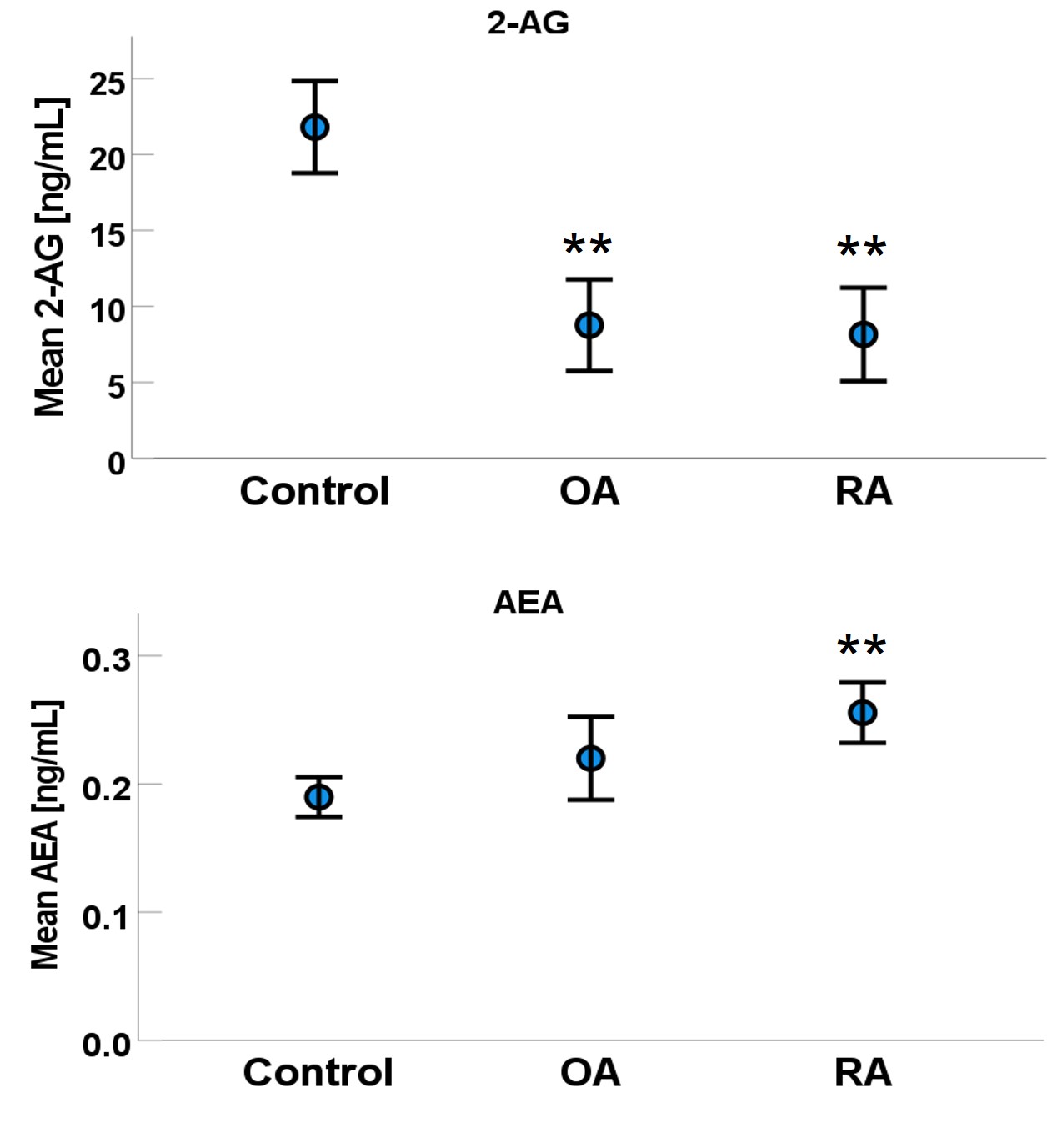Session Information
Date: Monday, November 13, 2023
Title: (1264–1307) RA – Diagnosis, Manifestations, and Outcomes Poster II
Session Type: Poster Session B
Session Time: 9:00AM-11:00AM
Background/Purpose: Inflammation is a complicated physiological process that results in a variety of disorders. Several inflammatory mediators are produced during this process, which is responsible for long-term inflammatory conditions like osteoarthritis (OA) and rheumatoid arthritis (RA). Endocannabinoids (ECs) and the endocannabinoid system play a pivotal role in the physiological response to pain and inflammation. A clinical study was performed to investigate changes in endocannabinoid tone and related lipid meditators in OA and RA compared to age-matched healthy participants.
Methods: A clinical study with 80 subjects (53 Female and 27 male) was performed including 25 RA and 18 OA patients and 37 healthy participants. Venous blood was drawn, plasma was generated, and one aliquot of plasma was acidified using 0.5% formic acid to preserve/stabilize endocannabinoids and related lipid mediators. An in-house developed and validated HPLC-MS/MS-based assay for the analysis of 20 ECs and congeners was performed as. Moreover, we applied a lipid mediator multiplex assay for the analysis of 131 oxylipins many of which are related to the ECs pathway. Data were analyzed using ANOVA in combination with the LSD post-hoc test (SPSS 28.0).
Results: Average age of study participants was 55.8±10.6 years with 57.2±8.3, 62.2±6.6 and 52.0±12.0 for the RA, OA and control group, respectively. The female/male ratio was 53/27 with 16/9, 15/3 and 22/15 for the RA, OA and control group, respectively. The endocannabinoid analysis revealed significantly decreased levels of 2-arachidonoylglycerol (2-AG, see Figure 1). In contrast, EC levels of the ethanolamide (EA) group (anandamide (AEA), docosahexaenoyl-EA, palmitoleoyl-EA and other EAs) were increased in the RA group and to a lesser extent in the OA group (Figure 1 lower part).This analysis of oxylipins revealed decreased levels of the inflammation resolving lipid 9-oxo-octadecadienoic acid (9-oxoODE) in RA compared to all other study groups. In contrast, proinflammatory lipids 11-hydroxy docosahexaenoic acid (11-HDHA) and 12-hydroxy-eicosatetraenoic acid (12-HETE) were significantly increased in both the RA and OA group as compared to healthy controls.
Conclusion: ECs have very short half-lives. The study design included addition of stabilizer solution to plasma that enabled us to accurately determine the EC levels, specifically 2-AG. Using this approach, we found decreased levels of the major antinociceptive and anti-inflammatory endocannabinoid 2-AG in RA and OA subjects. 2-AG is a key regulator of nociception and inflammation, and decreased levels could be a major mechanistic contributor to pain and inflammation in RA and OA. In addition, we observed increased levels of ethanolamide endocannabinoids (EA-ECs). This may be an indicator for decreased FAAH (fatty acid amide hydrolase) activity, the major EA-ECs regulating enzyme. Although anandamide (the major EA-EC) functions as a CB1 receptor agonist in the CNS, it shows vanilloid TRPV1 receptor agonism peripherally. Overall, our results suggest the involvement of ECs in inflammation and pain in patients with RA and OA and may present a potential treatment target.
Disclosures: J. Klawitter: None; A. Clauw: None; J. Seifert: None; J. Klawitter: None; B. Tompson: None; C. Sempio: None; U. Christians: None; L. Moreland: Boehringer-Ingelheim, 12, member of independent Data Safety Monitoring Board, Celltrion, 12, member of independent Data Safety Monitoring Board.
To cite this abstract in AMA style:
Klawitter J, Clauw A, Seifert J, Klawitter J, Tompson B, Sempio C, Christians U, Moreland L. Changes in the Endocannabinoid Tone in Rheumatoid Arthritis and Osteoarthritis – Discovery of a Novel Target for the Treatment of Pain and Inflammation? [abstract]. Arthritis Rheumatol. 2023; 75 (suppl 9). https://acrabstracts.org/abstract/changes-in-the-endocannabinoid-tone-in-rheumatoid-arthritis-and-osteoarthritis-discovery-of-a-novel-target-for-the-treatment-of-pain-and-inflammation/. Accessed .« Back to ACR Convergence 2023
ACR Meeting Abstracts - https://acrabstracts.org/abstract/changes-in-the-endocannabinoid-tone-in-rheumatoid-arthritis-and-osteoarthritis-discovery-of-a-novel-target-for-the-treatment-of-pain-and-inflammation/

